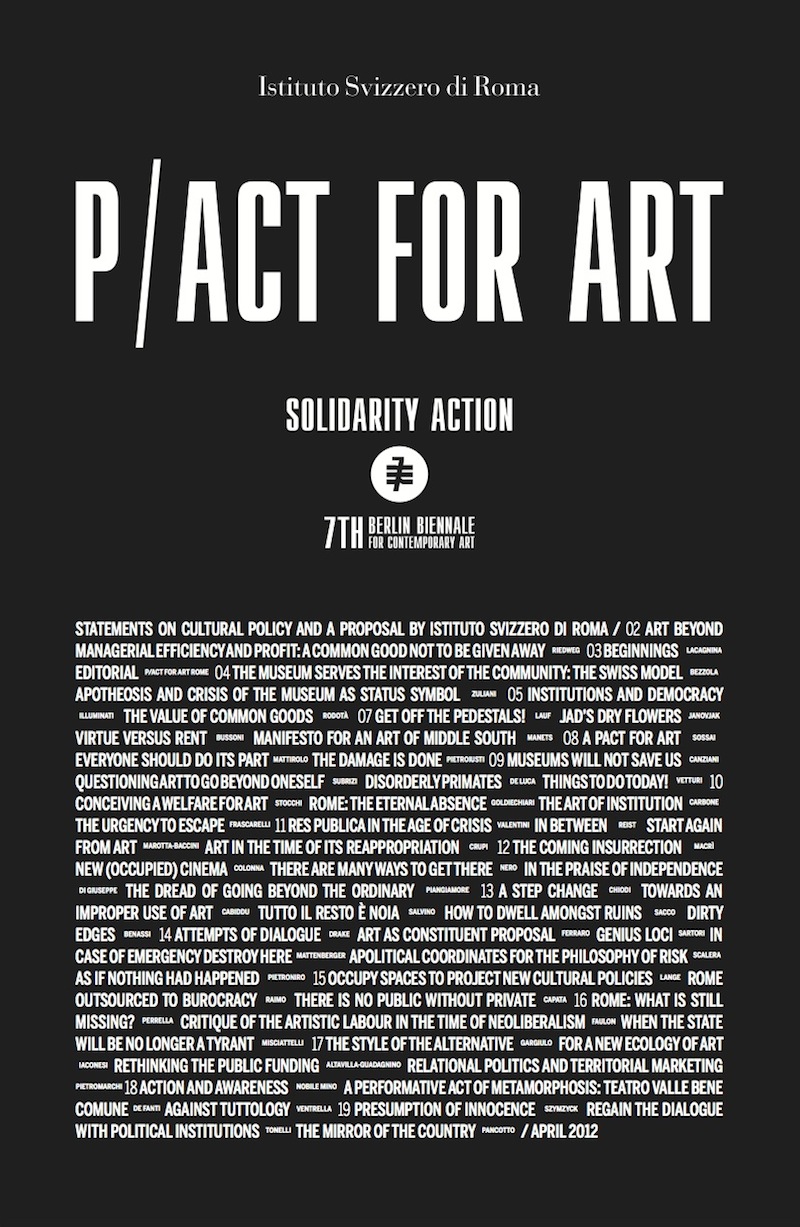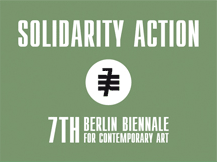
P/Act for Art is a freely distributed newspaper, published for the first time in Autumn 2011 in Berlin, in the ambit of the 7. Berlin Biennale. The Istituto Svizzero di Roma, together with other European entities, has recently undertaken a series of solidarity actions to explore the effects of art in society and the connections with current social and political situations. This you are holding comes out of this collaborative project: it is an instrument to reflect critically upon the cultural policies, artistic production and the institutions of Rome.
We took up and elaborated the ten questions that were previously used in the Berlin journal, submitting them to many active actors of the Roman cultural scene, and requesting their comments and proposals. Some of the questions that we used in Rome are identical to those in Berlin, because we believe that the problems and the needs of these two European cities are very similar; others were re-written by us, adapting them to the specific context of this city. From those questions, each collaborator expressed his/her position regarding the management of the funding of cultural and artistic institutions in the city where they live and/or work. We gathered nearly fifty contributions. The additional interventions, of those who were unable to send their texts within the deadline, will be published in a section of the blog solidarityaction.istitutosvizzero.org.
The survey goes beyond the single actors, echoing the rich heterogeneity of the artistic landscape, through the gaze of those who are actively connected to Rome. More than reflecting the criteria or choices of the editorial team of P/Act for Art Roma, the large diversity of experiences presented tries to trace a variegated constellation of voices and practices. In addition, some contributions are from the artists in residence at the Istituto Svizzero di Roma, who had the chance to have close contact with the city.
We wanted to privilege the new generation of artists, curators and actors of the cultural and artistic scene, believing that nowadays their experiences and opinions are of the highest importance for the challenges of the present.
The contributes that compose this journal vary in nature and kind: some include precise answers to the questions proposed; others are a short reflection upon specific aspects or insist upon specific aspects considered urgent. Personal comments go side-by-side with contributions that narrate collective practices, displaying a true laboratory to rethink the institutions of the world of culture, crossing fields of art, political activism and theoretical reflection.
An important feature of this journal is that it hosts the cultural and artistic realities of the urban independent scene, other than problematic experiences of occupation and self-management: these practices are directly questioning the institutions, norms and relations in which art and culture are produced, distributed and experienced.
The contrast between very different experiences helps us to observe Rome and its institutions, which we tried to give a central role in this research. This latter area of research has been analysed from different points of view and disciplines, starting from the contributions of the jurist Stefano Rodotà and of the thinker Augusto Illuminati, as a direct expression of the full debate that has developed in recent years in Rome around the practices of movements, as well as the concept of the common.
The research on the topic of institutions has been further deepened by the contribution of Tobia Bezzola, which highlights a model that can establish strong ties with the local dimension intertwined with the ability to produce original forms of social legitimacy. A condition that appears very distant from what is described by Stefania Zuliani on the case of recently created Italian museums.
P / Act for Art Roma wants to be the instrument to develop ideas for research, increase the intensity and quality of the connections between Switzerland and Italy from that federal model that evokes the experience of the Swiss Confederation, which has been placed at the centre of our discussion.
Thanks to the Istituto Svizzero di Roma, we addressed the local dimension of this city from an advantageous point of view: a European one. The open relationship with the 7. Berlin Biennale has helped us to further broaden the horizon of our intervention, deepening it. From this point of view, the publication in Italian and in English is an effort to circulate and extend this debate at an international level; we are also aware that the many challenges of Rome necessarily go beyond the narrow confines of the nation-state, through the constitution of an international network of individuals and experiences, capable of acting in solidarity with each other.
The title of this publication, as well as our activity, focused on the notion of pact, whose intersubjective dimension highlights cooperation and involves multiple actors and their intentions, which necessarily leads to political action.
Precisely for this reason, we would like to thank all those who accepted to take part in the construction of this project, helping us with their suggestions, critiques, ideas and proposals.
In particular, we thank those who generously shared their time with us to undertake this experiment. Without them this journal would simply not exist.


